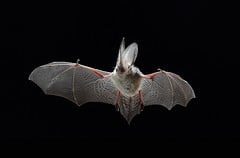In 2006, hibernating bats in upstate New York were identified with white-nose syndrome , a disease that produces a white fungal growth around the wings, mouth and nose of bats. The disease is a huge problem for North American bats, with it killing at least 6 million brown bats and the disease now spreading from New York to Mississippi and Canada. The disease may even threaten the entire bat species and disrupt the ecosystem. Scientific researchers have been studying WNS for over a decade and only recently have they developed a reason for its lethal effect on the North American bat population.
Researchers from the US Geological Survey and the University of Wisconsin learned that the fungus Pseudogymnoascus destructans kills brown bats by “increasing the amount of energy they use during hibernation”. When bats are hibernating during the winter, they must carefully save up their energy to survive without eating until the winter ends. The fungus drains bats of their energy and forces them to wake early and either starve or freeze to death. The study done by USGS measured how much fat was burned and at what rate during hibernation between non-infected and infected bats. Dr. Michelle Verant, a USGS National Wildlife Health Center scientist, found that bats infected with WNS used twice as much energy as the healthy bats during hibernation and had “potentially life-threatening physiologic imbalances that could inhibit normal body functions”.
The immune system of bats is very tolerant of pathogens and diseases that can be lethal to humans, like ebola and even some cancer cells. Bats are immune to many viruses and rarely show signs of disease so the visible white growth on the bats poses a huge threat to the ecosystem. Dr. David Blehert worked with Dr. Verant at the USGS National Wildlife Health Center and the WNS is scary because “here we have an animal that can survive some of the scariest viruses we know, and it’s undone by a common soil fungus.”
Main Article:
Other Articles of Interest:
http://www.eurekalert.org/pub_releases/2015-01/usgs-hdw010215.php
http://www.nytimes.com/2015/01/13/science/no-time-for-bats-to-rest-easy.html?ref=science&_r=0
http://www.biomedcentral.com/1472-6793/14/10
http://en.wikipedia.org/wiki/White_nose_syndrome



kysquared
Very interesting and unfortunate, sgagliocytosis. I wonder if human intervention can save the brown bat species. What if humans injected sedatives (http://en.wikipedia.org/wiki/Sedative) into brown bats with the white nose in an attempt to counteract the “energy-stealing” effect of the fungus? This leads to an interesting larger question about the human intervention of endangered species: should we be intervening in the cycle of life of certain species, or are some animals meant to go extinct and be replaced by more advanced counterparts (i.e. due to evolution)? By saving certain animals from extinction, are humans counteracting natural selection?